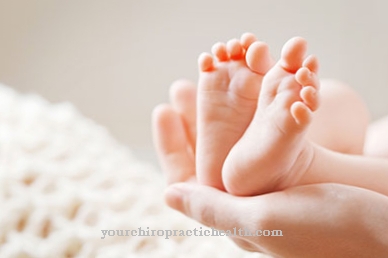The Hepatitis D, which belongs to the group of liver diseases is basically a notifiable disease that is caused by an infection and is harmful to health. Hepatitis D is of great epidemiological importance. Special microorganisms can trigger hepatitis D.
What is hepatitis D?

© viyadafotolia– stock.adobe.com
Hepatitis D is a liver disease that can occur in people who already have infectious hepatitis B or who are healthy.
The designation hepa- means that the liver is badly affected in hepatitis D. At the ending -it is' it can be seen that the hepatitis D is mainly inflammatory processes.
Basically, hepatitis D causes pathological and permanent damage to the liver cells that are essential for the metabolism in the body due to special triggers. In Germany, however, hepatitis D is considered a disease that rarely occurs.
causes
The causes of hepatitis D are easy to explain, because the results of scientific studies have shown that specific viruses can be the cause. Hepatitis D is about the pathogen known as the hepatitis D virus. This virus originates from hepatitis B and is characterized by a protein, HBsAg, located on the cell surface.
This is why people who are already infected with a hepatitis B virus are almost always infected with hepatitis D. Healthy people can become infected through food intake and through transmission of the virus from sick people. This can be done through contact fluids such as sperm, tear fluid, the mother's milk during breastfeeding, and saliva.
Blood and all other transmission media also get through the mucous membranes or injuries into the healthy organism and contribute to the hepatitis D infection.
Symptoms, ailments & signs
Hepatitis D only occurs together with hepatitis B because the HD virus needs the envelope protein of the HB virus to reproduce. The symptoms are similar to those of HBV infection. However, the course and severity of the symptoms depend on whether the patient is infected with both viruses at the same time (simultaneous infection) or whether the HDV infection occurs after an HBV infection (superinfection).
Chronic courses rarely occur with simultaneous infection because both viruses interfere with each other. However, the acute course of the disease can still be severe. As with an HBV infection, the simultaneous infection begins with unspecific symptoms such as tiredness, loss of appetite, fatigue, headache, joint pain, fever and pressure in the right upper abdomen. Diarrhea, nausea and vomiting can also occur.
Jaundice is also common. The skin and eyes turn yellow with simultaneous discoloration of the stool and darker color of the urine. In most cases, the hepatitis heals completely after a severe acute course of the disease with a simultaneous infection with both viruses.
However, if the HDV infection occurs after an HBV infection has almost been overcome, similar symptoms are observed, but they are usually even more severe. The infection then often progresses fulminantly to fatal liver failure. At the same time, a chronic course with the development of liver cirrhosis up to liver cancer is very common.
course
After a so-called incubation period, during which the viruses multiply, both chronic and acute signs of hepatitis D appear. Those affected who are infected with the hepatitis D virus tend to show unspecific symptoms that are flu-like and express themselves as exhaustion, tiredness, aching limbs and general discomfort.
In many cases, the skin and mucous membranes turn yellow, and jaundice develops. About 90 percent of those with hepatitis D get well again.
In addition to destruction of the liver and liver cancer, as well as severe impairment of the liver, those affected suffer from constant fever and general weakness in the presence of hepatitis B. In the majority of cases, the prognoses are very poor if, in addition to hepatitis D, hepatitis B and a so-called superinfection are present at the same time.
If the patient already suffers from hepatitis B, an infection with the pathogen typical for hepatitis D will increase the symptoms of the disease.
Complications
A sole infection with the hepatitis D virus is not possible; a previous infection with the hepatitis B virus is a prerequisite. Thus, infection with hepatitis D is rather harmless. It becomes more dangerous if the person concerned is infected with the hepatitis B and the hepatitis D virus at the same time.
This greatly increases the likelihood of developing chronic hepatitis. It is even more dangerous if someone already infected with hepatitis B is infected with the hepatitis D virus. This increases the risk of developing a chronic course and the probability of developing liver cirrhosis. With liver cirrhosis there is a severe reduction in quality of life.
The affected person is no longer able to synthesize proteins in sufficient quantities for the blood. These are in particular proteins that maintain the oncotic pressure and clotting proteins. This can result in water retention (edema) and the bleeding time is prolonged.
Furthermore, the liver can no longer detoxify adequately, the cell toxin ammonia accumulates, which can lead to disorders and paralysis in the central nervous system (hepatic encephalopathy). The likelihood of developing liver cancer in the course of cirrhosis is greatly increased. Life expectancy in general is limited in those affected.
When should you go to the doctor?
If you have hepatitis D, an immediate medical examination is necessary. This disease does not self-heal and it usually leads to death if left untreated.
In addition to the symptoms, the person affected should also check whether they have been in an area affected by hepatitis D in the past few weeks and months. A visit to the doctor is necessary if jaundice develops. Jaundice is the main symptom of all hepatitis diseases.
Usually, a high fever and tiredness or fatigue also indicate hepatitis D and should be examined by a doctor. Those affected suffer from weight loss, severe abdominal pain and anorexia. If hepatitis D is not treated, the affected person's liver will be completely destroyed.
The diagnosis and treatment of hepatitis D can be done by a general practitioner or in a hospital. Since a direct and complete cure of the disease is not possible, the patients are usually dependent on long-term therapy.
Doctors & therapists in your area
Treatment & Therapy
Although hepatitis D is an extremely debilitating, protracted, dangerous disease that can be associated with serious health consequences, the therapeutic options are largely limited.
Treatments are also available to address the individual symptoms of hepatitis D. In principle, a one-year therapy with interferon can be implemented. In hepatitis D, this can lead to the pathogenic virus being rendered harmless. However, this drug is considered controversial in terms of its effects in hepatitis D.
Treatment of hepatitis D is usually carried out using the same methods that are indicated for hepatitis B. However, not all therapeutic measures are equally effective.
No drugs can currently cure hepatitis D. Only painkillers to alleviate the painful symptoms and drugs against nausea and vomiting are used in the treatment of hepatitis D.
Outlook & forecast
Timely diagnosis is particularly important for the course of hepatitis D. Therefore, anyone who has acute or chronic hepatitis B should definitely be examined for hepatitis D infection. The test is simple and can be done with a simple blood test.
The course can often not be predicted with certainty, since the treatment of hepatitis D is very challenging. The virus-related, chronic inflammation of the liver can now be treated with success. For example, interferon therapy, as used in the treatment of the B virus, is also effective in hepatitis D.
As it turned out, this preparation significantly reduces the virus replication rate. However, the therapy is not always 100% effective. Often, the infection recurs after a temporary stop. Therefore, relapses may occur after the end of therapy. Sometimes these only show up years after the treatment.
Hepatitis D can lead to severe liver damage, liver inflammation and even liver failure. This can lead to a number of (sometimes serious) functional disorders of the organism. It is therefore particularly important to stop the progressive and ever increasing strain on the liver. Interferon cannot stop the progression of the disease with any guarantee in the long term, but it nevertheless enables long, symptom-free phases.
prevention
Prevention against hepatitis D is particularly recommended if you are planning to travel to Mediterranean countries and other predominantly tropical and subtropical continents, or if you have increased contact with potentially infected people.
This applies to special professional groups. In this context, vaccination against hepatitis D is the only sensible precaution. In this regard, a preventive vaccination against hepatitis B with weakened pathogens is effective as a hepatitis D prophylaxis.
Aftercare
For hepatitis D, follow-up care proves to be relatively difficult in most cases. As a rule, the disease must first be treated comprehensively so that there are no further complications or a further worsening of the symptoms. The earlier the hepatitis D is detected, the better the further course of the disease is usually.
The disease can only be treated symptomatically. The person concerned should always pay attention to a strict bed rest so as not to strain the body unnecessarily. In any case, physical or stressful activities should be avoided. In many cases, medication can also be taken to relieve the symptoms of hepatitis D.
It is important to ensure the correct dosage and regular intake of these medications so that the symptoms can be alleviated. Regular examinations by an internist are also of great importance, especially the liver of the person concerned should be examined. During treatment, the patient must change their diet to light food to relieve the liver. Hepatitis D may also lead to a reduced life expectancy for those affected.
You can do that yourself
An outbreak of hepatitis D must definitely be clarified and treated by a doctor. A number of measures and remedies from the household and nature can be used against the individual symptoms.
A healthy and balanced diet with sufficient vitamins, minerals and trace elements is particularly essential. This enables the immune system to quickly find its way back to its optimal performance. Patients should also drink plenty of water. Luxury foods such as alcohol, nicotine or caffeine should be avoided as far as possible. Those affected should exercise regularly and cure the disease well through bed rest.
Various types of tea (e.g. milk thistle, yarrow, birch leaves), artichoke juice and baths with seed oats or essential oils are available for liver problems. Relieving preparations such as marigold ointment or valerian drops help relieve pain.
An alternative to this is the ozone autologous blood treatment, in which the autologous blood is enriched with ozone. At home, those affected can use Shiatsu treatment and other Chinese medicine methods.
The best measure, however, is to avoid the outbreak of hepatitis D by seeing a doctor if you have hepatitis B.

.jpg)




.jpg)

















.jpg)



